E-Commerce Strategy, SWOT, and KPIs at De Montfort University
VerifiedAdded on 2023/06/14
|9
|1784
|475
Report
AI Summary
This report provides an analysis of an e-commerce strategy for De Montfort University, focusing on expanding its international student base through distance learning. The report includes a SWOT analysis identifying strengths, weaknesses, opportunities, and threats associated with online course delivery. It also outlines objectives, critical success factors, and key performance indicators (KPIs) using Porter's Five Forces model to assess the competitive landscape. Furthermore, the report addresses potential issues in the university's website and proposes solutions to enhance online communication and cultural diversity. The recommendations suggest leveraging online tools and diversifying teaching staff to build trust and attract a wider range of international students. This resource is available for students needing support, with Desklib offering a range of solved assignments and past papers.
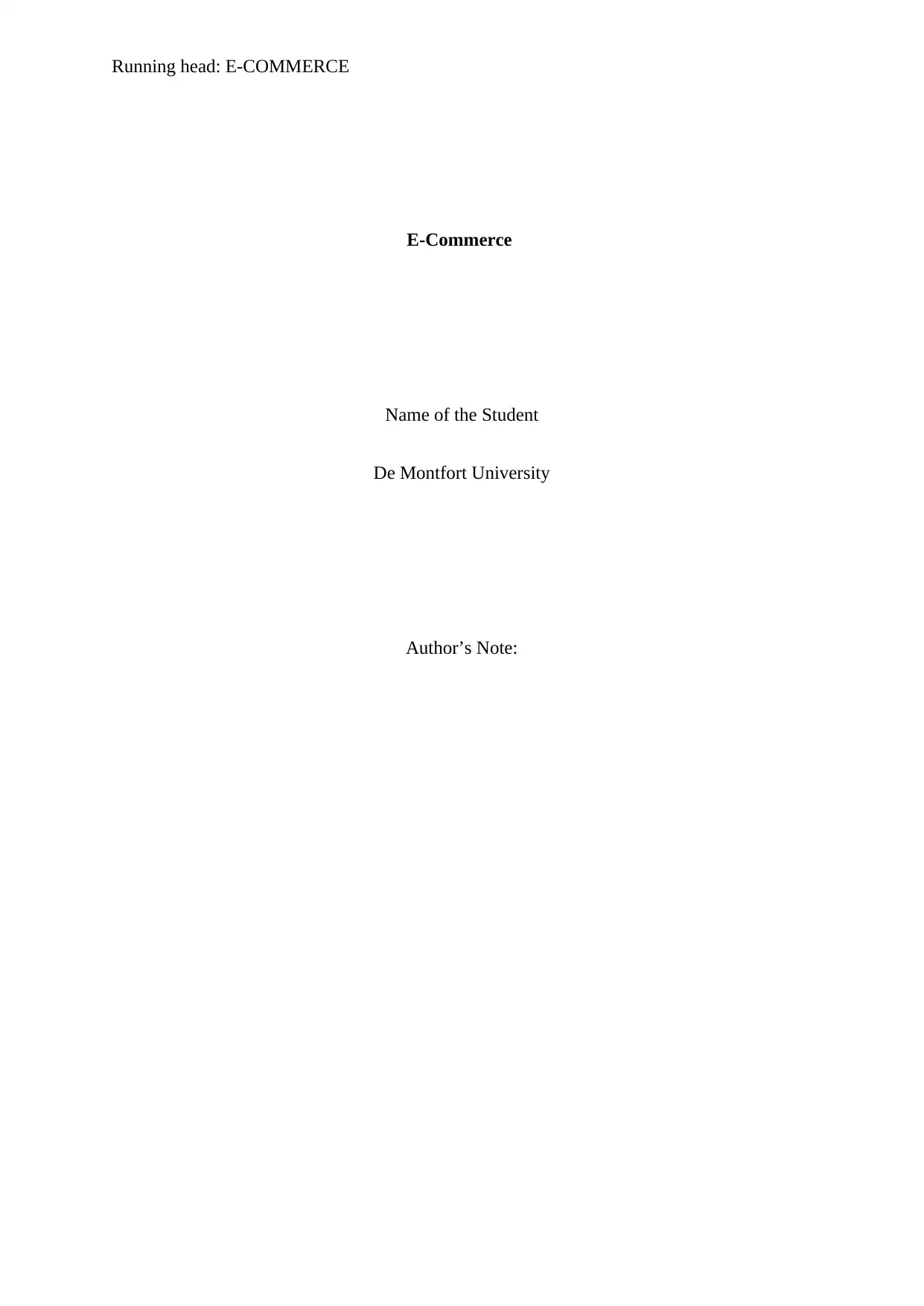
Running head: E-COMMERCE
E-Commerce
Name of the Student
De Montfort University
Author’s Note:
E-Commerce
Name of the Student
De Montfort University
Author’s Note:
Paraphrase This Document
Need a fresh take? Get an instant paraphrase of this document with our AI Paraphraser
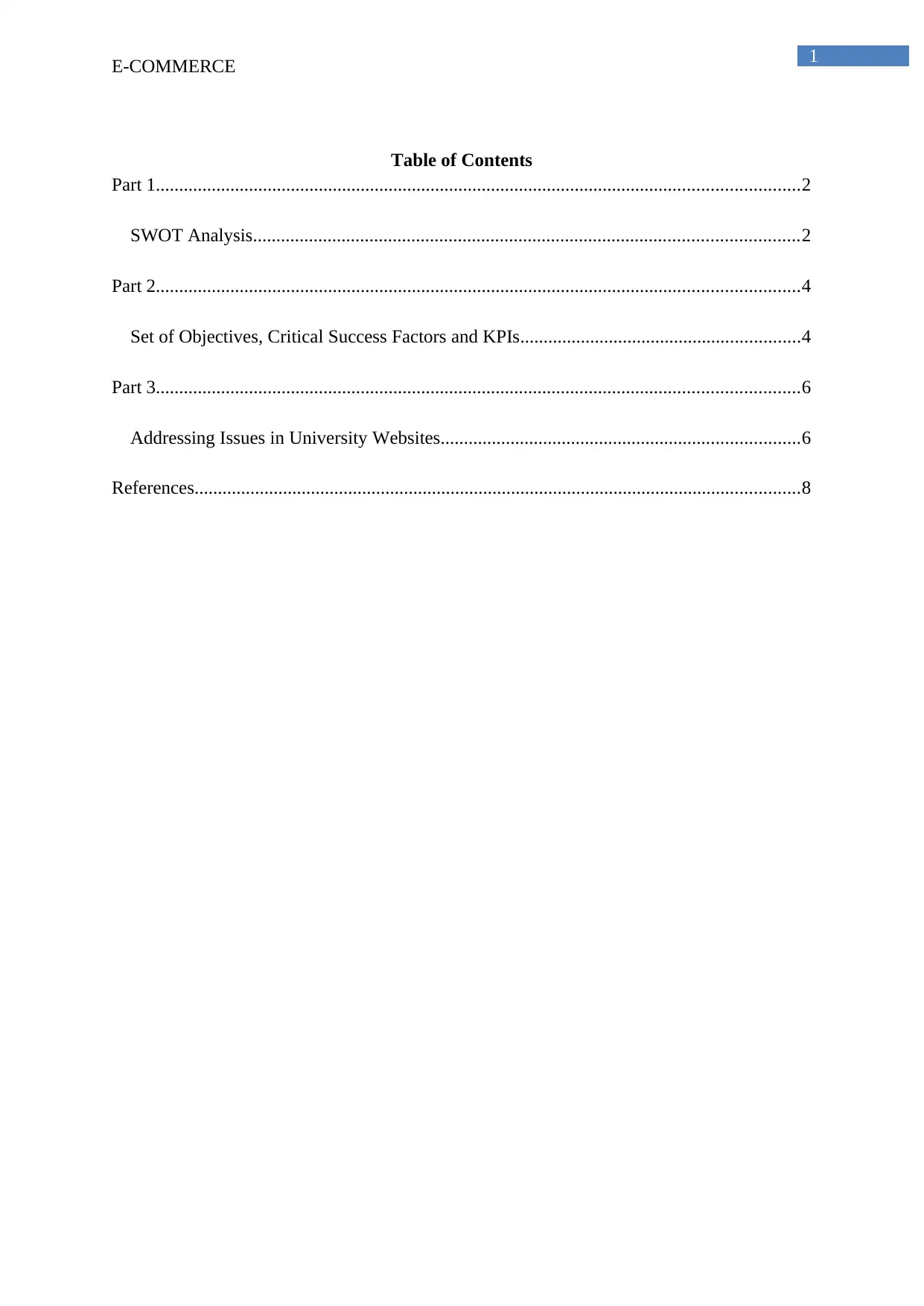
1
E-COMMERCE
Table of Contents
Part 1..........................................................................................................................................2
SWOT Analysis.....................................................................................................................2
Part 2..........................................................................................................................................4
Set of Objectives, Critical Success Factors and KPIs............................................................4
Part 3..........................................................................................................................................6
Addressing Issues in University Websites.............................................................................6
References..................................................................................................................................8
E-COMMERCE
Table of Contents
Part 1..........................................................................................................................................2
SWOT Analysis.....................................................................................................................2
Part 2..........................................................................................................................................4
Set of Objectives, Critical Success Factors and KPIs............................................................4
Part 3..........................................................................................................................................6
Addressing Issues in University Websites.............................................................................6
References..................................................................................................................................8
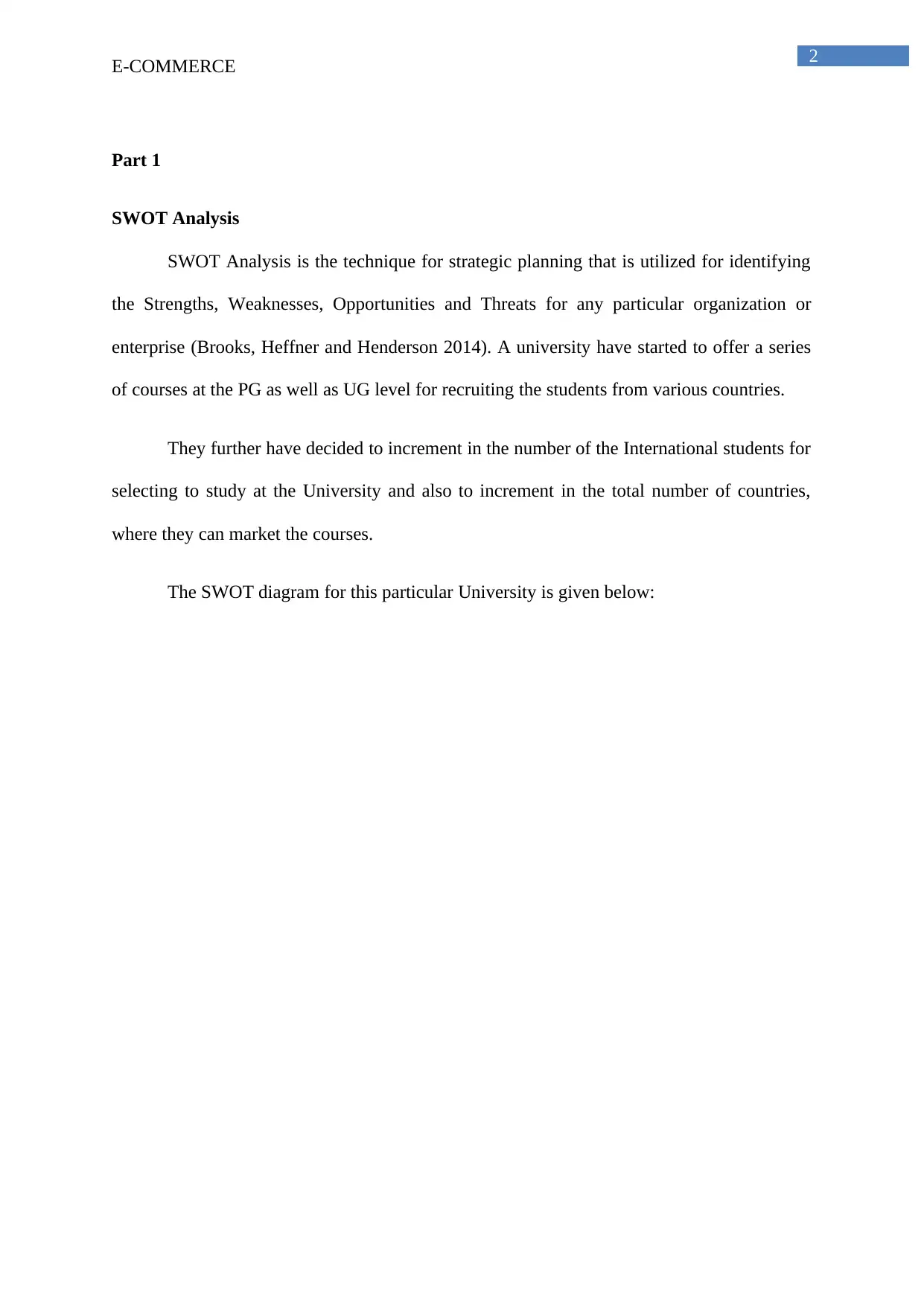
2
E-COMMERCE
Part 1
SWOT Analysis
SWOT Analysis is the technique for strategic planning that is utilized for identifying
the Strengths, Weaknesses, Opportunities and Threats for any particular organization or
enterprise (Brooks, Heffner and Henderson 2014). A university have started to offer a series
of courses at the PG as well as UG level for recruiting the students from various countries.
They further have decided to increment in the number of the International students for
selecting to study at the University and also to increment in the total number of countries,
where they can market the courses.
The SWOT diagram for this particular University is given below:
E-COMMERCE
Part 1
SWOT Analysis
SWOT Analysis is the technique for strategic planning that is utilized for identifying
the Strengths, Weaknesses, Opportunities and Threats for any particular organization or
enterprise (Brooks, Heffner and Henderson 2014). A university have started to offer a series
of courses at the PG as well as UG level for recruiting the students from various countries.
They further have decided to increment in the number of the International students for
selecting to study at the University and also to increment in the total number of countries,
where they can market the courses.
The SWOT diagram for this particular University is given below:
⊘ This is a preview!⊘
Do you want full access?
Subscribe today to unlock all pages.

Trusted by 1+ million students worldwide
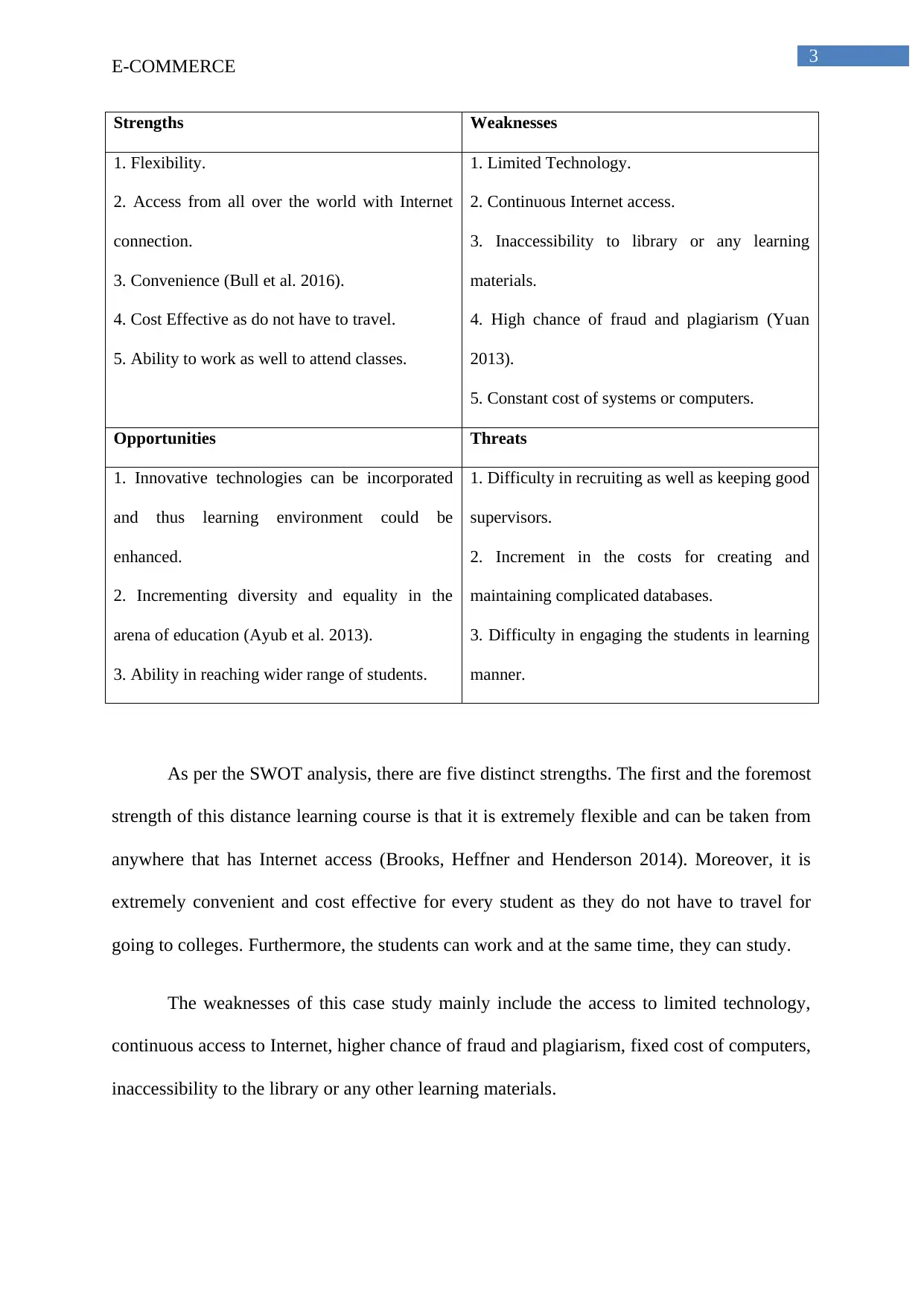
3
E-COMMERCE
Strengths Weaknesses
1. Flexibility.
2. Access from all over the world with Internet
connection.
3. Convenience (Bull et al. 2016).
4. Cost Effective as do not have to travel.
5. Ability to work as well to attend classes.
1. Limited Technology.
2. Continuous Internet access.
3. Inaccessibility to library or any learning
materials.
4. High chance of fraud and plagiarism (Yuan
2013).
5. Constant cost of systems or computers.
Opportunities Threats
1. Innovative technologies can be incorporated
and thus learning environment could be
enhanced.
2. Incrementing diversity and equality in the
arena of education (Ayub et al. 2013).
3. Ability in reaching wider range of students.
1. Difficulty in recruiting as well as keeping good
supervisors.
2. Increment in the costs for creating and
maintaining complicated databases.
3. Difficulty in engaging the students in learning
manner.
As per the SWOT analysis, there are five distinct strengths. The first and the foremost
strength of this distance learning course is that it is extremely flexible and can be taken from
anywhere that has Internet access (Brooks, Heffner and Henderson 2014). Moreover, it is
extremely convenient and cost effective for every student as they do not have to travel for
going to colleges. Furthermore, the students can work and at the same time, they can study.
The weaknesses of this case study mainly include the access to limited technology,
continuous access to Internet, higher chance of fraud and plagiarism, fixed cost of computers,
inaccessibility to the library or any other learning materials.
E-COMMERCE
Strengths Weaknesses
1. Flexibility.
2. Access from all over the world with Internet
connection.
3. Convenience (Bull et al. 2016).
4. Cost Effective as do not have to travel.
5. Ability to work as well to attend classes.
1. Limited Technology.
2. Continuous Internet access.
3. Inaccessibility to library or any learning
materials.
4. High chance of fraud and plagiarism (Yuan
2013).
5. Constant cost of systems or computers.
Opportunities Threats
1. Innovative technologies can be incorporated
and thus learning environment could be
enhanced.
2. Incrementing diversity and equality in the
arena of education (Ayub et al. 2013).
3. Ability in reaching wider range of students.
1. Difficulty in recruiting as well as keeping good
supervisors.
2. Increment in the costs for creating and
maintaining complicated databases.
3. Difficulty in engaging the students in learning
manner.
As per the SWOT analysis, there are five distinct strengths. The first and the foremost
strength of this distance learning course is that it is extremely flexible and can be taken from
anywhere that has Internet access (Brooks, Heffner and Henderson 2014). Moreover, it is
extremely convenient and cost effective for every student as they do not have to travel for
going to colleges. Furthermore, the students can work and at the same time, they can study.
The weaknesses of this case study mainly include the access to limited technology,
continuous access to Internet, higher chance of fraud and plagiarism, fixed cost of computers,
inaccessibility to the library or any other learning materials.
Paraphrase This Document
Need a fresh take? Get an instant paraphrase of this document with our AI Paraphraser
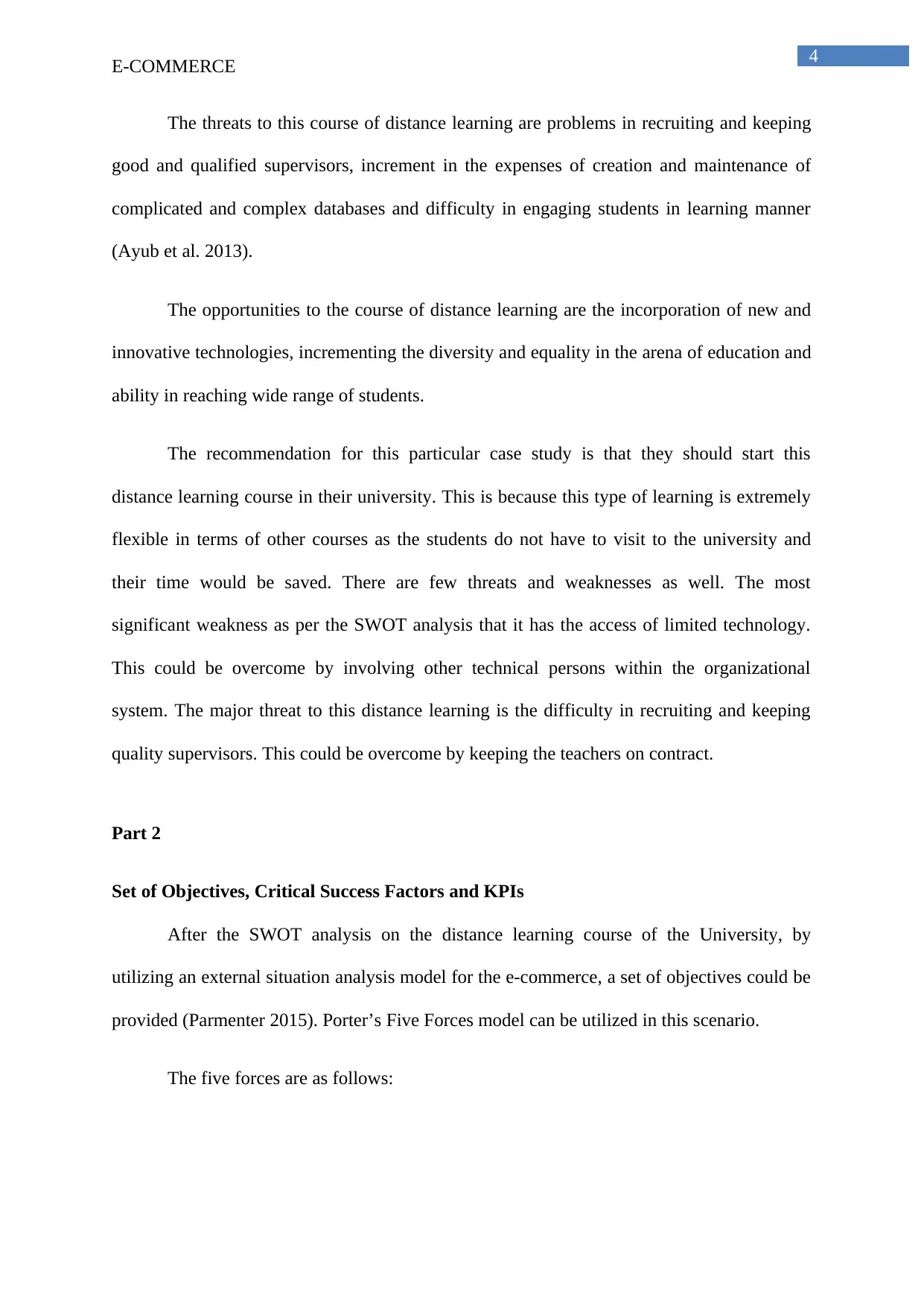
4
E-COMMERCE
The threats to this course of distance learning are problems in recruiting and keeping
good and qualified supervisors, increment in the expenses of creation and maintenance of
complicated and complex databases and difficulty in engaging students in learning manner
(Ayub et al. 2013).
The opportunities to the course of distance learning are the incorporation of new and
innovative technologies, incrementing the diversity and equality in the arena of education and
ability in reaching wide range of students.
The recommendation for this particular case study is that they should start this
distance learning course in their university. This is because this type of learning is extremely
flexible in terms of other courses as the students do not have to visit to the university and
their time would be saved. There are few threats and weaknesses as well. The most
significant weakness as per the SWOT analysis that it has the access of limited technology.
This could be overcome by involving other technical persons within the organizational
system. The major threat to this distance learning is the difficulty in recruiting and keeping
quality supervisors. This could be overcome by keeping the teachers on contract.
Part 2
Set of Objectives, Critical Success Factors and KPIs
After the SWOT analysis on the distance learning course of the University, by
utilizing an external situation analysis model for the e-commerce, a set of objectives could be
provided (Parmenter 2015). Porter’s Five Forces model can be utilized in this scenario.
The five forces are as follows:
E-COMMERCE
The threats to this course of distance learning are problems in recruiting and keeping
good and qualified supervisors, increment in the expenses of creation and maintenance of
complicated and complex databases and difficulty in engaging students in learning manner
(Ayub et al. 2013).
The opportunities to the course of distance learning are the incorporation of new and
innovative technologies, incrementing the diversity and equality in the arena of education and
ability in reaching wide range of students.
The recommendation for this particular case study is that they should start this
distance learning course in their university. This is because this type of learning is extremely
flexible in terms of other courses as the students do not have to visit to the university and
their time would be saved. There are few threats and weaknesses as well. The most
significant weakness as per the SWOT analysis that it has the access of limited technology.
This could be overcome by involving other technical persons within the organizational
system. The major threat to this distance learning is the difficulty in recruiting and keeping
quality supervisors. This could be overcome by keeping the teachers on contract.
Part 2
Set of Objectives, Critical Success Factors and KPIs
After the SWOT analysis on the distance learning course of the University, by
utilizing an external situation analysis model for the e-commerce, a set of objectives could be
provided (Parmenter 2015). Porter’s Five Forces model can be utilized in this scenario.
The five forces are as follows:
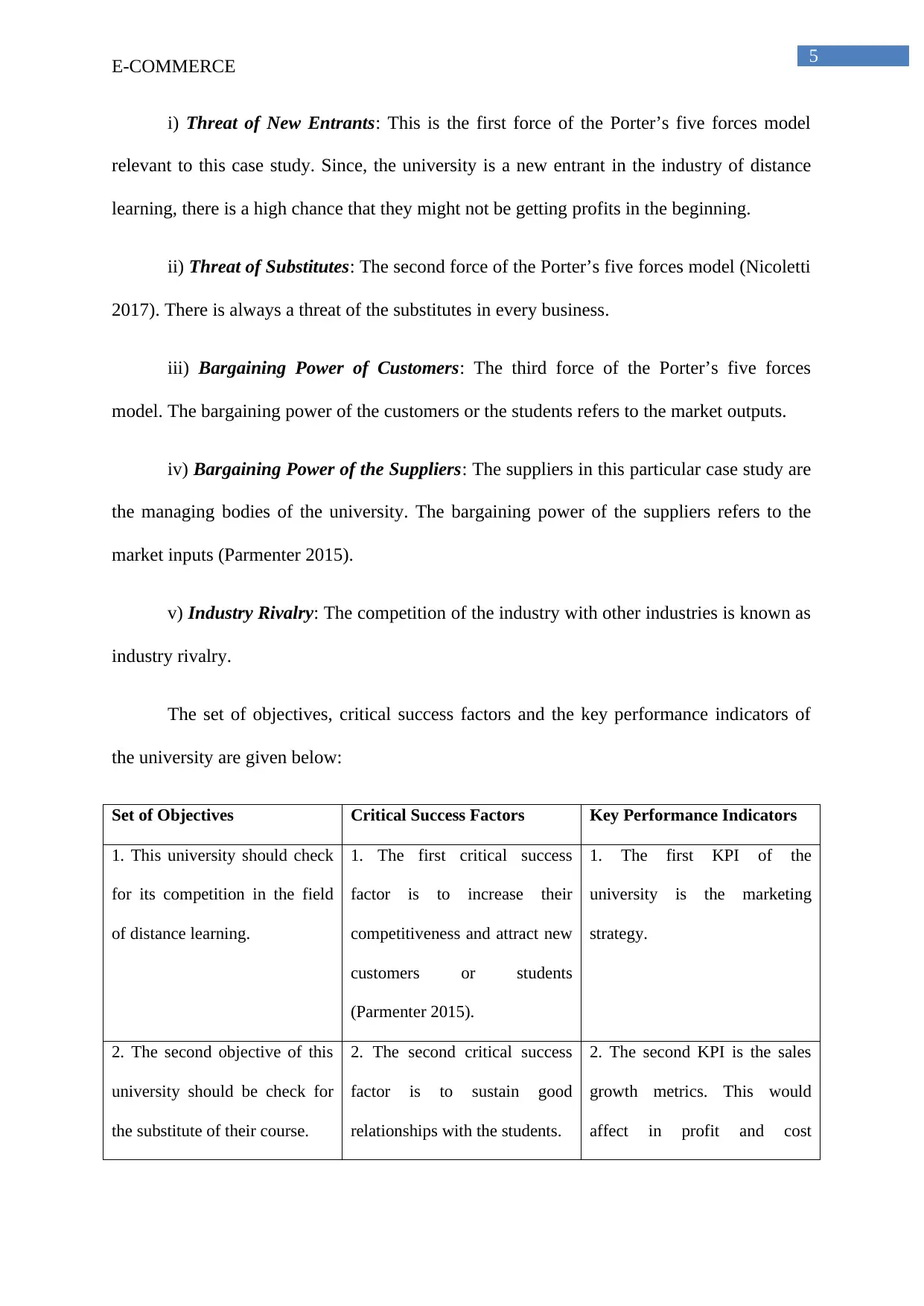
5
E-COMMERCE
i) Threat of New Entrants: This is the first force of the Porter’s five forces model
relevant to this case study. Since, the university is a new entrant in the industry of distance
learning, there is a high chance that they might not be getting profits in the beginning.
ii) Threat of Substitutes: The second force of the Porter’s five forces model (Nicoletti
2017). There is always a threat of the substitutes in every business.
iii) Bargaining Power of Customers: The third force of the Porter’s five forces
model. The bargaining power of the customers or the students refers to the market outputs.
iv) Bargaining Power of the Suppliers: The suppliers in this particular case study are
the managing bodies of the university. The bargaining power of the suppliers refers to the
market inputs (Parmenter 2015).
v) Industry Rivalry: The competition of the industry with other industries is known as
industry rivalry.
The set of objectives, critical success factors and the key performance indicators of
the university are given below:
Set of Objectives Critical Success Factors Key Performance Indicators
1. This university should check
for its competition in the field
of distance learning.
1. The first critical success
factor is to increase their
competitiveness and attract new
customers or students
(Parmenter 2015).
1. The first KPI of the
university is the marketing
strategy.
2. The second objective of this
university should be check for
the substitute of their course.
2. The second critical success
factor is to sustain good
relationships with the students.
2. The second KPI is the sales
growth metrics. This would
affect in profit and cost
E-COMMERCE
i) Threat of New Entrants: This is the first force of the Porter’s five forces model
relevant to this case study. Since, the university is a new entrant in the industry of distance
learning, there is a high chance that they might not be getting profits in the beginning.
ii) Threat of Substitutes: The second force of the Porter’s five forces model (Nicoletti
2017). There is always a threat of the substitutes in every business.
iii) Bargaining Power of Customers: The third force of the Porter’s five forces
model. The bargaining power of the customers or the students refers to the market outputs.
iv) Bargaining Power of the Suppliers: The suppliers in this particular case study are
the managing bodies of the university. The bargaining power of the suppliers refers to the
market inputs (Parmenter 2015).
v) Industry Rivalry: The competition of the industry with other industries is known as
industry rivalry.
The set of objectives, critical success factors and the key performance indicators of
the university are given below:
Set of Objectives Critical Success Factors Key Performance Indicators
1. This university should check
for its competition in the field
of distance learning.
1. The first critical success
factor is to increase their
competitiveness and attract new
customers or students
(Parmenter 2015).
1. The first KPI of the
university is the marketing
strategy.
2. The second objective of this
university should be check for
the substitute of their course.
2. The second critical success
factor is to sustain good
relationships with the students.
2. The second KPI is the sales
growth metrics. This would
affect in profit and cost
⊘ This is a preview!⊘
Do you want full access?
Subscribe today to unlock all pages.

Trusted by 1+ million students worldwide
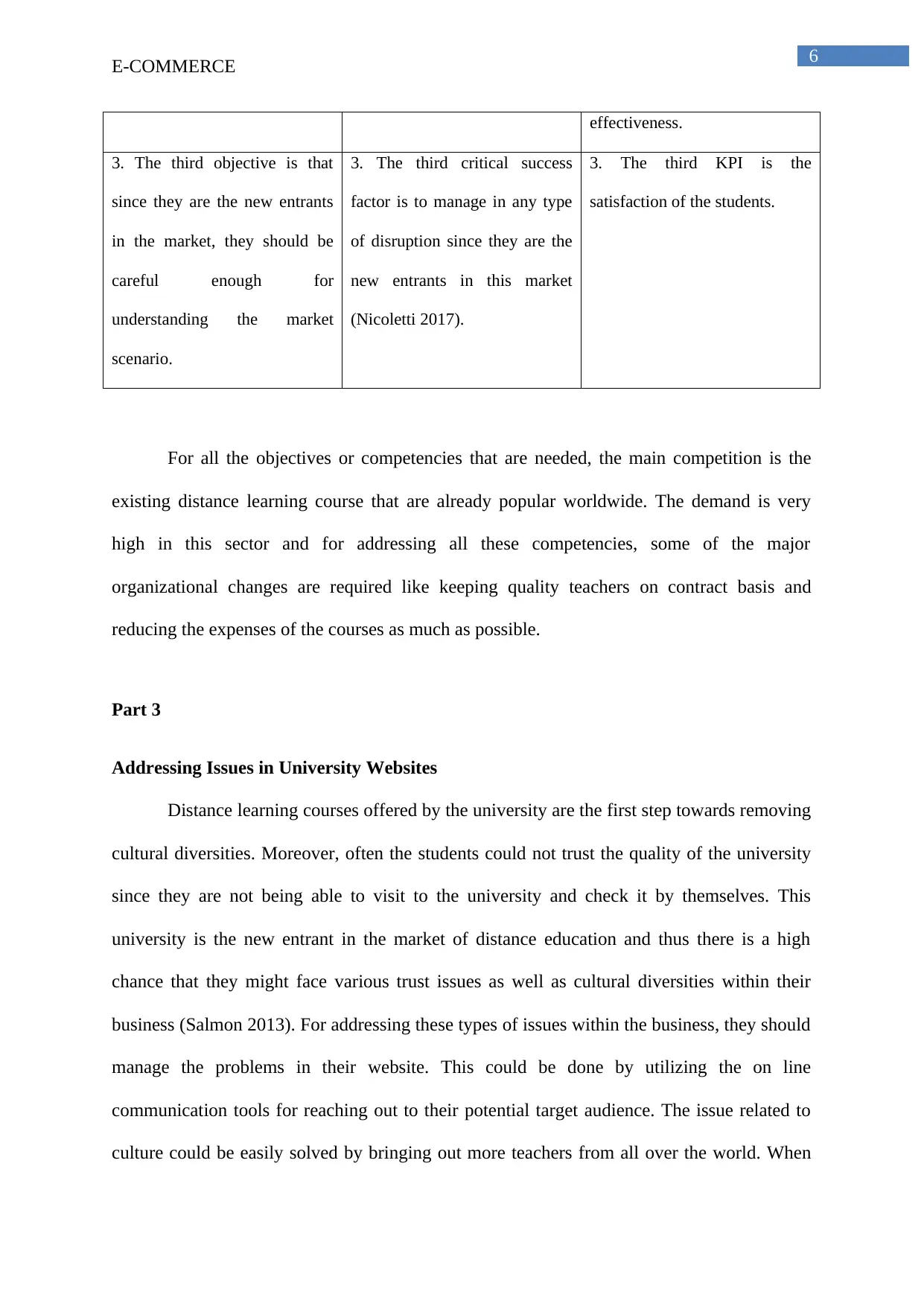
6
E-COMMERCE
effectiveness.
3. The third objective is that
since they are the new entrants
in the market, they should be
careful enough for
understanding the market
scenario.
3. The third critical success
factor is to manage in any type
of disruption since they are the
new entrants in this market
(Nicoletti 2017).
3. The third KPI is the
satisfaction of the students.
For all the objectives or competencies that are needed, the main competition is the
existing distance learning course that are already popular worldwide. The demand is very
high in this sector and for addressing all these competencies, some of the major
organizational changes are required like keeping quality teachers on contract basis and
reducing the expenses of the courses as much as possible.
Part 3
Addressing Issues in University Websites
Distance learning courses offered by the university are the first step towards removing
cultural diversities. Moreover, often the students could not trust the quality of the university
since they are not being able to visit to the university and check it by themselves. This
university is the new entrant in the market of distance education and thus there is a high
chance that they might face various trust issues as well as cultural diversities within their
business (Salmon 2013). For addressing these types of issues within the business, they should
manage the problems in their website. This could be done by utilizing the on line
communication tools for reaching out to their potential target audience. The issue related to
culture could be easily solved by bringing out more teachers from all over the world. When
E-COMMERCE
effectiveness.
3. The third objective is that
since they are the new entrants
in the market, they should be
careful enough for
understanding the market
scenario.
3. The third critical success
factor is to manage in any type
of disruption since they are the
new entrants in this market
(Nicoletti 2017).
3. The third KPI is the
satisfaction of the students.
For all the objectives or competencies that are needed, the main competition is the
existing distance learning course that are already popular worldwide. The demand is very
high in this sector and for addressing all these competencies, some of the major
organizational changes are required like keeping quality teachers on contract basis and
reducing the expenses of the courses as much as possible.
Part 3
Addressing Issues in University Websites
Distance learning courses offered by the university are the first step towards removing
cultural diversities. Moreover, often the students could not trust the quality of the university
since they are not being able to visit to the university and check it by themselves. This
university is the new entrant in the market of distance education and thus there is a high
chance that they might face various trust issues as well as cultural diversities within their
business (Salmon 2013). For addressing these types of issues within the business, they should
manage the problems in their website. This could be done by utilizing the on line
communication tools for reaching out to their potential target audience. The issue related to
culture could be easily solved by bringing out more teachers from all over the world. When
Paraphrase This Document
Need a fresh take? Get an instant paraphrase of this document with our AI Paraphraser
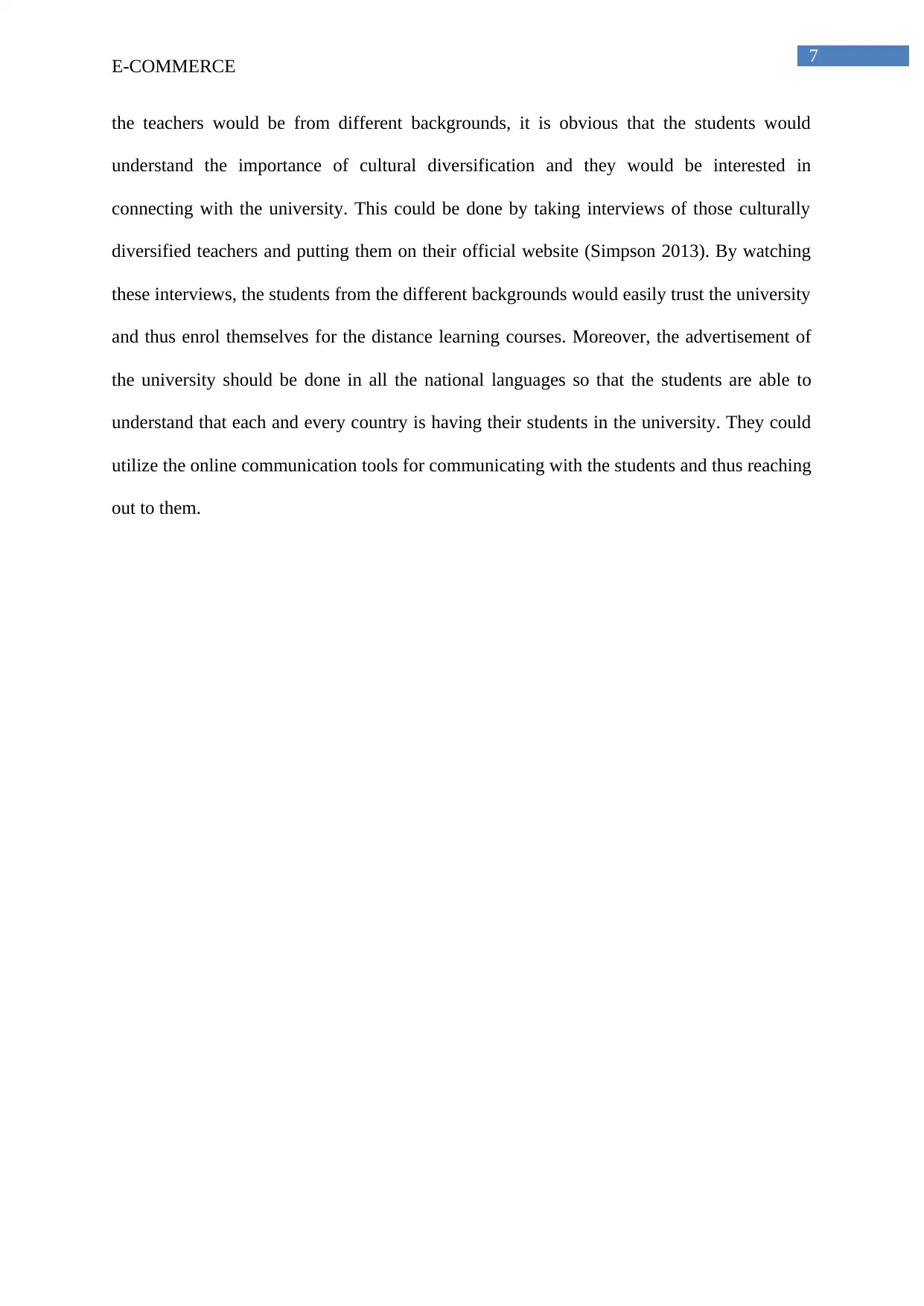
7
E-COMMERCE
the teachers would be from different backgrounds, it is obvious that the students would
understand the importance of cultural diversification and they would be interested in
connecting with the university. This could be done by taking interviews of those culturally
diversified teachers and putting them on their official website (Simpson 2013). By watching
these interviews, the students from the different backgrounds would easily trust the university
and thus enrol themselves for the distance learning courses. Moreover, the advertisement of
the university should be done in all the national languages so that the students are able to
understand that each and every country is having their students in the university. They could
utilize the online communication tools for communicating with the students and thus reaching
out to them.
E-COMMERCE
the teachers would be from different backgrounds, it is obvious that the students would
understand the importance of cultural diversification and they would be interested in
connecting with the university. This could be done by taking interviews of those culturally
diversified teachers and putting them on their official website (Simpson 2013). By watching
these interviews, the students from the different backgrounds would easily trust the university
and thus enrol themselves for the distance learning courses. Moreover, the advertisement of
the university should be done in all the national languages so that the students are able to
understand that each and every country is having their students in the university. They could
utilize the online communication tools for communicating with the students and thus reaching
out to them.
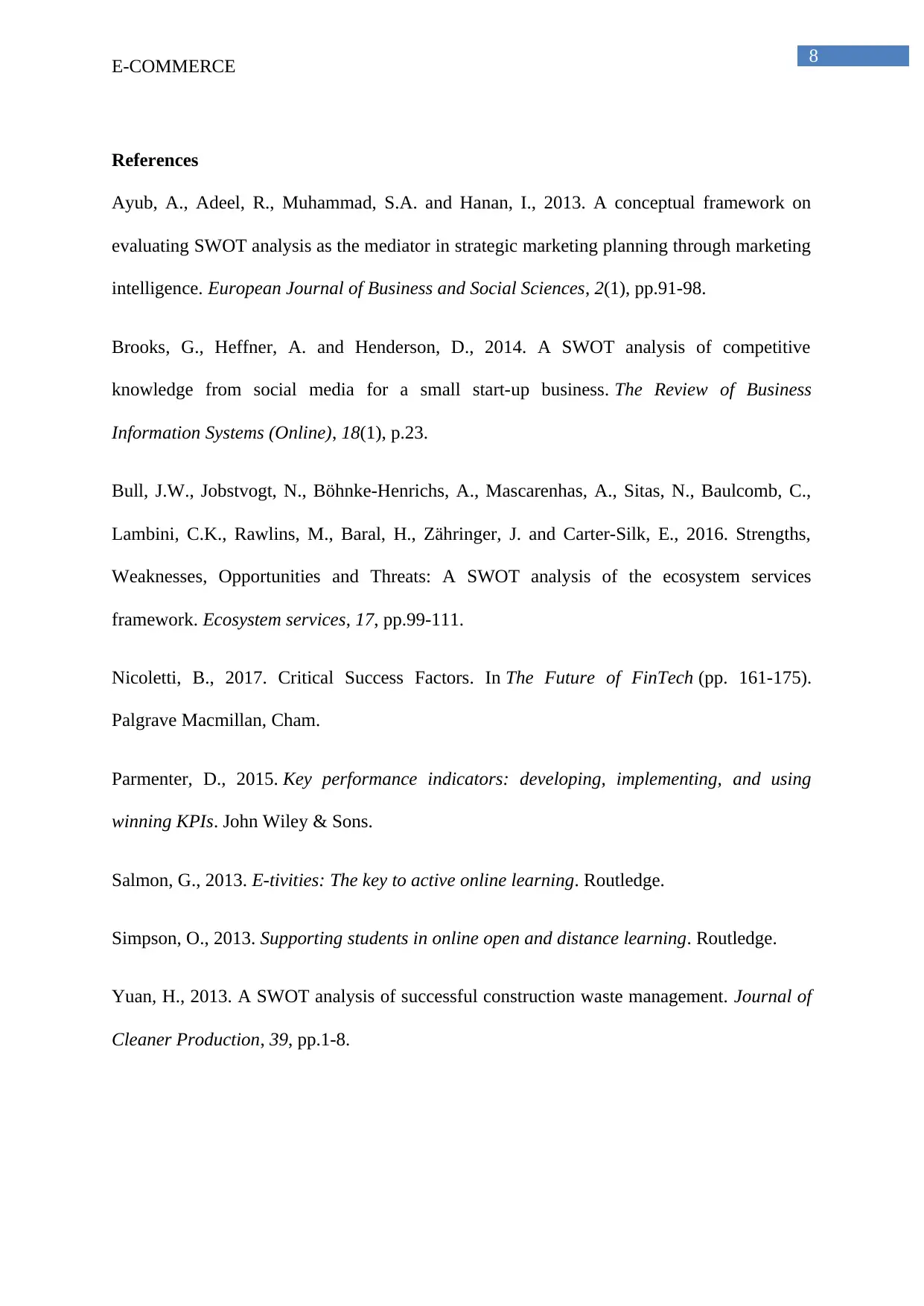
8
E-COMMERCE
References
Ayub, A., Adeel, R., Muhammad, S.A. and Hanan, I., 2013. A conceptual framework on
evaluating SWOT analysis as the mediator in strategic marketing planning through marketing
intelligence. European Journal of Business and Social Sciences, 2(1), pp.91-98.
Brooks, G., Heffner, A. and Henderson, D., 2014. A SWOT analysis of competitive
knowledge from social media for a small start-up business. The Review of Business
Information Systems (Online), 18(1), p.23.
Bull, J.W., Jobstvogt, N., Böhnke-Henrichs, A., Mascarenhas, A., Sitas, N., Baulcomb, C.,
Lambini, C.K., Rawlins, M., Baral, H., Zähringer, J. and Carter-Silk, E., 2016. Strengths,
Weaknesses, Opportunities and Threats: A SWOT analysis of the ecosystem services
framework. Ecosystem services, 17, pp.99-111.
Nicoletti, B., 2017. Critical Success Factors. In The Future of FinTech (pp. 161-175).
Palgrave Macmillan, Cham.
Parmenter, D., 2015. Key performance indicators: developing, implementing, and using
winning KPIs. John Wiley & Sons.
Salmon, G., 2013. E-tivities: The key to active online learning. Routledge.
Simpson, O., 2013. Supporting students in online open and distance learning. Routledge.
Yuan, H., 2013. A SWOT analysis of successful construction waste management. Journal of
Cleaner Production, 39, pp.1-8.
E-COMMERCE
References
Ayub, A., Adeel, R., Muhammad, S.A. and Hanan, I., 2013. A conceptual framework on
evaluating SWOT analysis as the mediator in strategic marketing planning through marketing
intelligence. European Journal of Business and Social Sciences, 2(1), pp.91-98.
Brooks, G., Heffner, A. and Henderson, D., 2014. A SWOT analysis of competitive
knowledge from social media for a small start-up business. The Review of Business
Information Systems (Online), 18(1), p.23.
Bull, J.W., Jobstvogt, N., Böhnke-Henrichs, A., Mascarenhas, A., Sitas, N., Baulcomb, C.,
Lambini, C.K., Rawlins, M., Baral, H., Zähringer, J. and Carter-Silk, E., 2016. Strengths,
Weaknesses, Opportunities and Threats: A SWOT analysis of the ecosystem services
framework. Ecosystem services, 17, pp.99-111.
Nicoletti, B., 2017. Critical Success Factors. In The Future of FinTech (pp. 161-175).
Palgrave Macmillan, Cham.
Parmenter, D., 2015. Key performance indicators: developing, implementing, and using
winning KPIs. John Wiley & Sons.
Salmon, G., 2013. E-tivities: The key to active online learning. Routledge.
Simpson, O., 2013. Supporting students in online open and distance learning. Routledge.
Yuan, H., 2013. A SWOT analysis of successful construction waste management. Journal of
Cleaner Production, 39, pp.1-8.
⊘ This is a preview!⊘
Do you want full access?
Subscribe today to unlock all pages.

Trusted by 1+ million students worldwide
1 out of 9
Related Documents
Your All-in-One AI-Powered Toolkit for Academic Success.
+13062052269
info@desklib.com
Available 24*7 on WhatsApp / Email
![[object Object]](/_next/static/media/star-bottom.7253800d.svg)
Unlock your academic potential
Copyright © 2020–2025 A2Z Services. All Rights Reserved. Developed and managed by ZUCOL.




